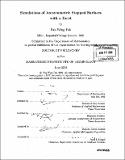| dc.contributor.advisor | Rodolfo Ruben Rosales and Dionisios Margetis. | en_US |
| dc.contributor.author | Fok, Pak-Wing | en_US |
| dc.contributor.other | Massachusetts Institute of Technology. Dept. of Mathematics. | en_US |
| dc.date.accessioned | 2006-11-07T12:54:12Z | |
| dc.date.available | 2006-11-07T12:54:12Z | |
| dc.date.copyright | 2006 | en_US |
| dc.date.issued | 2006 | en_US |
| dc.identifier.uri | http://hdl.handle.net/1721.1/34548 | |
| dc.description | Thesis (Ph. D.)--Massachusetts Institute of Technology, Dept. of Mathematics, 2006. | en_US |
| dc.description | Includes bibliographical references (p. 255-266). | en_US |
| dc.description.abstract | A crystal lattice with a small miscut from the plane of symmetry has a surface which consists of a series of atomic height steps separated by terraces. If the surface of this crystal is not in equilibrium with the surrounding medium, then its evolution is strongly mediated by the presence of these steps, which act as sites for attachment and detachment of diffusing adsorbed atoms ('adatoms'). In the absence of material deposition and evaporation, steps move in response to two main physical effects: line tension, which is caused by curvature of the step edge, and step-step interactions which can arise because of thermal step fluctuations, or elastic effects. This thesis focuses on axisymmetric crystals, with the result that the position of a step is uniquely described by a single scalar variable, and the step positions obey a coupled system of "step-flow" Ordinary Differential Equations (step flow ODEs). Chapter 2 of this thesis concentrates on the derivation and numerical solution of these equations, and their properties in the limits of slow adatom terrace diffusion and slow adatom attachment-detachment. Chapter 3 focuses on the analysis carried out by Margetis, Aziz and Stone ('MAS') [78] on a Partial Differential Equation (PDE) description of surface evolution. | en_US |
| dc.description.abstract | (cont.) Here, the crystal is also axisymmetric and has a single macroscopically flat region, a facet. It is discovered that the boundary condition of Step Chemical Potential Continuity, first suggested by Spohn [109] yields results that are inconsistent with the scalings predicted by the MAS analysis and with results from the step flow ODEs. The 'step drop' condition suggested by Israeli and Kandel [50] is implemented instead, and is shown to give good agreement with the results from the step flow ODEs. Chapters 4 and 5 explore the evolution of algebraic profiles: instead of starting with steps that are equally spaced, the step radii are initialized as a more general algebraic function of the height. In these two chapters, results are presented which involve approximate self-similarity of the profiles, a stability analysis of small perturbations, and quantification of decay rates. Chapter 6 of this thesis details the numerical procedure used to integrate the step flow equations. A 'multi-adaptive' time integrator is used where different time steps are taken for different components of the solution. This procedure has benefits over a standard integrator, because when a few steps cluster tightly together, these steps (and these steps only) become very stiff to integrate. | en_US |
| dc.description.abstract | (cont.) Whereas the inner most steps in the structure undergo a rapid motion, the majority of steps which are sufficiently far away from the facet, move relatively slowly and exhibit smooth behaviour in time. Using the same time step for all components in the solution is therefore quite inefficient. This chapter discusses the concept of "local stiffness", and how the motion of the inner most steps is handled. | en_US |
| dc.description.statementofresponsibility | by Pak-Wing Fok. | en_US |
| dc.format.extent | 266 p. | en_US |
| dc.format.extent | 13162424 bytes | |
| dc.format.extent | 13180260 bytes | |
| dc.format.mimetype | application/pdf | |
| dc.format.mimetype | application/pdf | |
| dc.language.iso | eng | en_US |
| dc.publisher | Massachusetts Institute of Technology | en_US |
| dc.rights | M.I.T. theses are protected by copyright. They may be viewed from this source for any purpose, but reproduction or distribution in any format is prohibited without written permission. See provided URL for inquiries about permission. | en_US |
| dc.rights.uri | http://dspace.mit.edu/handle/1721.1/7582 | |
| dc.subject | Mathematics. | en_US |
| dc.title | Simulation of axisymmetric stepped surfaces with a facet | en_US |
| dc.type | Thesis | en_US |
| dc.description.degree | Ph.D. | en_US |
| dc.contributor.department | Massachusetts Institute of Technology. Department of Mathematics | |
| dc.identifier.oclc | 71015502 | en_US |
